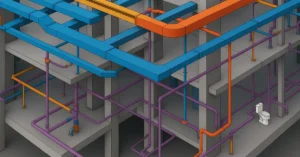As a beginner in the field of architecture in Germany, it can be daunting to navigate the complex web of building regulations and standards. From planning permission to safety regulations and energy efficiency, there are numerous requirements that must be met in order to design and construct a building in compliance with German law.
In this beginner’s guide, we’ll provide an overview of the most important regulations and standards for architecture in Germany. Whether you’re just starting out in the industry or simply looking to refresh your knowledge, this guide will provide valuable insights and practical advice.

Exploring the Key Requirements and Guidelines for Architects and Builders in Germany
Planning Permission and Building Codes
One of the first steps in any construction project is obtaining planning permission from the local authorities. In Germany, this process is governed by a number of building codes, including the Baugesetzbuch (Building Code) and the Bauordnung (Building Regulations).
These codes set out the requirements for building design, safety, and sustainability, as well as the procedures for obtaining planning permission and complying with building codes. They also specify the minimum standards for materials and construction methods, as well as the conditions for maintaining and renovating buildings.
Energy Efficiency and Sustainability
In recent years, energy efficiency and sustainability have become increasingly important considerations in building design and construction. Germany has been a leader in this area, with stringent energy efficiency standards and a strong commitment to sustainable building practices.
The Energy Saving Ordinance (EnEV) sets out the minimum energy efficiency standards for new buildings, while the Renewable Energy Heat Act (EEWärmeG) requires a minimum share of renewable energy sources in heating and cooling systems. Additionally, the German Sustainable Building Council (DGNB) provides a certification system for sustainable buildings, which takes into account factors such as energy efficiency, materials, and indoor environmental quality.
Safety Regulations
Safety is another critical consideration in building design and construction. The German Building Regulations (BauV) set out the safety requirements for building design and construction, including fire safety, structural safety, and accessibility. In addition, the Occupational Safety and Health Act (ArbSchG) requires employers to ensure the safety and health of their employees on construction sites. This includes providing appropriate safety equipment and training, as well as complying with safety regulations and building codes.
In addition to the regulations and standards mentioned above, there are other important considerations that architects and builders should be aware of. These include:
Accessibility:
The German Environmental Protection Act (BImSchG) sets out regulations for noise protection, including noise insulation standards for buildings located near busy roads or airports.
Noise protection:
The German Environmental Protection Act (BImSchG) sets out regulations for noise protection, including noise insulation standards for buildings located near busy roads or airports.
Fire protection:
The German Building Regulations also include requirements for fire protection, including fire-resistant materials and sprinkler systems in certain types of buildings.
Historic preservation:
In some cases, buildings or areas may be subject to historic preservation regulations, which can limit the types of changes that can be made to the building or surrounding area.
While these regulations and standards can seem overwhelming, they are ultimately in place to ensure the safety, sustainability, and efficiency of buildings in Germany. By staying up-to-date with the latest requirements and guidelines, architects and builders can create buildings that are not only compliant with local laws, but also contribute to a better quality of life for occupants and a more sustainable future for the planet.
Conclusion
Navigating the regulations and standards for architecture in Germany can be a complex and challenging process, but it’s essential for ensuring that buildings are safe, sustainable, and compliant with local laws. By understanding the key requirements and regulations, architects and builders can design and construct buildings that meet the highest standards of safety, sustainability, and efficiency.
Whether you’re just starting out in the industry or looking to refresh your knowledge, this guide provides a comprehensive overview of the most important regulations and standards for architecture in Germany. From planning permission to safety regulations and energy efficiency, these requirements are critical for anyone working in the field of architecture in Germany.
In conclusion, understanding the building regulations and standards for architecture in Germany is essential for anyone working in the industry. From planning permission to safety regulations and energy efficiency, compliance with these regulations is critical for creating buildings that are safe, sustainable, and efficient. By staying informed and up-to-date on the latest requirements, architects and builders can create buildings that not only meet the highest standards of quality, but also contribute to a better future for all.
For more SketchUp tutorials you can check out https://www.sketchupguru.com/blog/
You can also check more tutorial videos for sketchup on our YouTube Channel,
https://www.youtube.com/c/SketchupGuru
To know about the Top Online 3D Rendering Courses for 2022 click,










